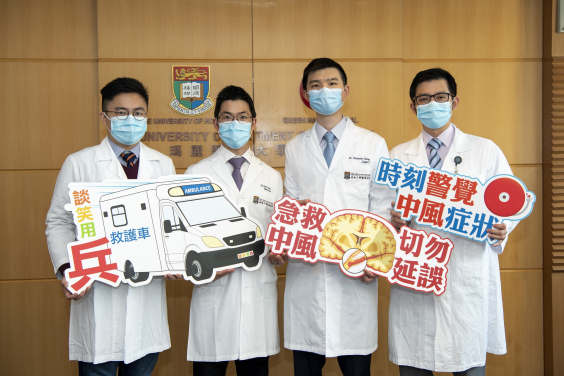Media
HKUMed research shows that stroke patients are presenting to hospitals one hour later during COVID-19, potentially jeopardising the patients’ eligibility for treatments and affecting the outcome
15 Apr 2020

Members of HKU Stroke (from left to right): Dr William CY Leung, Dr Gary Lau Kui-kai, Dr Anderson Tsang Chun-on and Dr Teo Kay-cheong highlight the importance of recognising stroke symptoms and seeking medical help as soon as possible despite COVID-19 pandemic to ensure best chance of recovery from acute stroke.
Stroke is the second most common cause of death and the most common cause of disability in the world. Hong Kong recorded its first Coronavirus Disease 2019 (COVID-19) case on January 23, 2020 and is currently in its containment phase without sustained community spread. Non-emergency services throughout hospitals in Hong Kong have been adjusted to cope with the outbreak, while emergency services such as acute stroke treatment have been maintained as much as possible. However, it is uncertain whether COVID-19 has influenced public behaviour in seeking medical attention for stroke and whether stroke services have been affected.
Researchers at The Stroke Research and Prevention Group (HKU Stroke), LKS Faculty of Medicine of The University of Hong Kong (HKUMed) analysed 73 patients who presented to the Accident and Emergency (A&E) Services of Queen Mary Hospital with symptoms of a stroke during the first two months of COVID-19 locally (January 23, 2020 – March 24, 2020), and compared these with 89 patients during a similar period in 2019 (January 23, 2019 – March 24, 2019). They found that, despite similar clinical characteristics between the two groups, patients who presented during the COVID-19 pandemic sought medical attention via the A&E on average 60 minutes later, compared with patients in 2019 (154 vs 95 minutes). Importantly, during the period, only 55% of patients with stroke were presented to hospitals within the therapeutic time window for thrombolysis treatment (4.5 hours from symptom onset), which was ~20% lower compared with the preceding year (55% vs 72%). Furthermore, much fewer patients with a mini-stroke or transient ischaemic attack (TIA) were presented to hospitals during COVID-19 (4% vs 16%). Reassuringly, during COVID-19, it appeared that in-hospital stroke services at Queen Mary Hospital, flagship teaching hospital of HKUMed, were nevertheless not affected and timings of in-patient stroke pathways, such as those from hospital admission to giving treatment, remained similar during and before COVID-19.
Dr Gary Lau Kui-kai, Director of HKU Stroke who was in charge of the study commented, “Delays in seeking care or not seeking care in stroke patients could be detrimental to stroke outcome. Time is brain and for every minute that stroke is not treated, it has been estimated that up to 1.9 million brain neurons will be lost. Earlier treatment for stroke is associated with better outcome and any delays in seeking care would seriously jeopardise the patient’s eligibility for treatment. For example, intravenous thrombolysis, an effective ‘clot-busting’ medication for patients with blockages within the arteries causing the stroke (ischaemic stroke) can traditionally only be provided if the patient presents to hospital within 4.5 hours of their symptom onset. Our results unfortunately show that, during COVID-19, as patients with stroke are presenting to hospital later, far fewer patients will be eligible for thrombolysis.”
Dr Teo Kay-cheong, Specialist in Neurology, and Honorary Tutor of the Department of Medicine, HKUMed further commented, “Our results are worrying as it highlights the reluctance of stroke patients in seeking timely hospital treatment during the current COVID-19 pandemic. It appears from our study that far fewer patients with a mini-stroke or TIA are seeking medical attention. Yet, TIAs are potentially devastating as up to 20% of patients with TIA may subsequently develop a disabling stroke within the subsequent three months. Early treatment of TIA could potentially reduce their risk of a stroke by up to 80%.” Dr Teo is a core member of the research team.
Dr Anderson Tsang Chun-on, Co-Director of HKU Stroke and Clinical Assistant Professor in Neurosurgery, also commented, “We are committed to providing the best acute stroke treatment, including thrombolysis and endovascular thrombectomy, to our patients despite the pandemic. It is reassuring to see that whilst Hong Kong is still in the containment phase of managing COVID-19, stroke services in Queen Mary Hospital have been mostly maintained. Unfortunately, in some countries that have been hard-hit by the outbreak, stroke centres have been reorganised to assist the fight against COVID-19, thus affecting stroke service. As we are seeing a further increase in COVID-19 cases in Hong Kong, we should make every effort to ensure that acute stroke care is not compromised to prevent potentially treatable stroke patients being denied appropriate treatment during this pandemic.”
FAST slogan
It is crucial for people in society to know about the symptoms of stroke, such that they could seek prompt medical attention. The FAST slogan is commonly used to remind the community of the symptoms of stroke and what to do when stroke is suspected. FAST stands for Facial weakness, Arm weakness, Slurring of speech and then it’s Time to call for help or dial 999.
About the Research Team
The research was conducted by a team led by Dr Gary Lau Kui-kai, Director of the Stroke Research and Prevention Group (HKU Stroke) and Clinical Assistant Professor in Neurology, HKUMed as well as Dr Anderson Tsang Chun-on, Co-Director of HKU Stroke and Clinical Assistant Professor in Neurosurgery, HKUMed. The mission of HKU Stroke is to further understand what causes stroke, and how to better prevent and manage it. HKU Stroke also strives to improve the well-being of stroke patients and their caregivers. For details, please refer to the website http://stroke.hku.hk and /or facebook page: http://www.facebook.com/HKUstroke/
The project was supported by the Mr. and Mrs. Tam Wing Fan Stroke and Dementia Research Fund.
Media enquiries
Please contact LKS Faculty of Medicine of The University of Hong Kong by email (medmedia@hku.hk).
